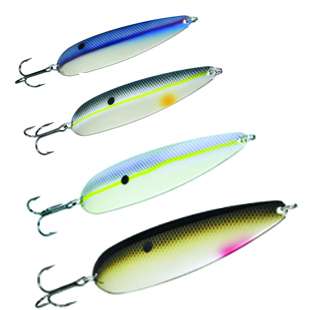
"It's the most wonderful time of the year." That could be the Christmas tune Mark Davis hums when he fishes his home waters in Arkansas during December. "This is probably the absolute best time to fish on the lakes where I live," says the 1995 Bassmaster Classic champ.
"The fish are schooled up and are feeding heavily, so this is probably my favorite time of the year to fish." While there are "parties for hosting, marshmallows for toasting and caroling out in the snow," Davis prefers spending the holiday season vertically jigging a spoon in the deep clear-water lakes near home. "This is the time of year when that pattern really works the best," says Davis.
The Elite Series pro finds bass this time of year in depths of 25 to 50 feet mostly along creek channels, but points, isolated trees on points or flats and deep brushpiles are also productive spots for Davis' jigging spoon.
Finding baitfish and then targeting structure adjacent to the bait is a key to this pattern. The depth of the bass will vary depending on the water clarity and baitfish location. "A rule of thumb is the clearer the water, the deeper you'll tend to find those bass," says Davis. "Another key is to pay attention to what depth the shad are.
For instance, if you're seeing a lot of shad at 25 feet, if you look for a good drop at the same depth or slightly deeper than where you're seeing the shad, you're going to be in the right depth." Bass will be suspended or on the bottom in deep water during this time.
"You can catch them in situations where they're not on the bottom — for instance, in standing timber," says Davis. "You can catch them jigging a spoon in the timber, but more times than not those fish are harder to target and catch. If you can find them on or near the bottom and right under the shad, they're a lot easier to catch."
A Strike King Sexy Spoon produces for Davis when the fish are less than 25 feet deep, but when he needs to reach deeper bass, he counts on a 3/4- or 1-ounce silver Hopkins-style spoon. The only modification he makes to the spoon is replacing the treble hook with a stronger 2X or 3X treble.
The Arkansas pro will position his boat directly over the fish and present his spoon vertically when he finds bass deeper than 30 feet. "If they're less than 25 feet, I'll tend to sit off of them slightly and make a short cast to them," he says.
After dropping his spoon to the bottom, Davis raises his rod from the 8 o'clock to 11 o'clock position to lift the spoon about a foot to 18 inches off the bottom. He works the spoon with a 7-foot medium-heavy All Star rod and a Pflueger Patriarch high-speed baitcast reel spooled with 20-pound Stren Fluorocarbon.
Davis notices many anglers make the mistake of jerking their spoons too hard and overworking the lure. "All you really want to do is just pop it or lift it up and let it fall on a slack line," says Davis, who also suggests paying close attention to how high you raise your spoon. "A lot of times you won't feel a strike, your lure just won't go back down to the bottom."
The spooning pattern produces numbers of 3- to 4-pound bass for Davis during the Yuletide season. "You're going to catch a lot of keeper bass and quality fish. I've caught some big ones doing it, but this is probably not the best way to target big fish."
As the surface water temperature keeps dropping throughout December, the spooning pattern continues to produce for Davis. However, the pattern starts to dissipate after the New Year holiday if the water temperature becomes uniform throughout the water column.
Then some of the fish start to scatter and make a move towards the shallows once a warming trend occurs.
Originally published January 2011





